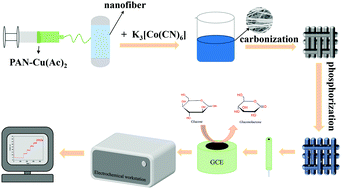Electrospinning one-dimensional surface-phosphorized CuCo/C nanofibers for enzyme-free glucose sensing†
Abstract
Developing novel electrocatalysts is of great importance for the practical application of non-enzymatic glucose sensors. One-dimensional (1D) carbon fiber-supported copper–cobalt bimetallic electrocatalysts (CuCo-P350) are successfully prepared via electrospinning technology and pyrolysis treatment. The morphology and structure of the composites are analyzed by XRD, SEM, TEM, and XPS. The CuCo-P350 is utilized as the electrocatalyst for non-enzymatic glucose sensors. Its 1D nano-structure provides highly exposed active sites and rapid charge transfer channels. Moreover, the surface phosphorization enhances its electrocatalytic activity. The CuCo-P350 delivers a superior sensitivity of 2272 μA mM−1 cm−2 in the range of 100–500 μM. In a large linear range of 5–825 μM, it exhibits an excellent sensitivity of 1100 μA mM−1 cm−2 with a low detection limit of 2.92 μM. The CuCo-P350 exhibits acceptable anti-interference ability, good reproducibility, and stability. The sensor can be used in human serum detection. Our results provide a reference for the structure design and fabrication of novel electrocatalysts for non-enzymatic glucose sensors.



 Please wait while we load your content...
Please wait while we load your content...